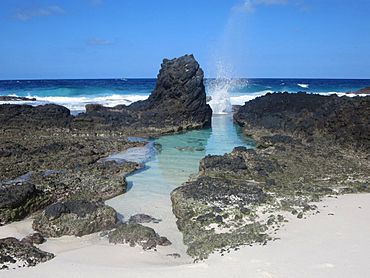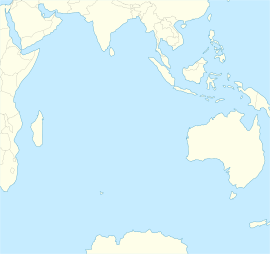Christmas Island National Park facts for kids
Quick facts for kids Christmas Island National ParkAustralia |
|
|---|---|
|
IUCN Category II (National Park)
|
|

Dolly Beach in Christmas Island National Park, Australia
|
|
| Nearest town or city | Flying Fish Cove |
| Established | 1980 |
| Area | 85 km2 (32.8 sq mi) |
| Managing authorities | Director of National Parks |
| Website | Christmas Island National Park |
Christmas Island National Park is a special protected area that covers most of Christmas Island. This island is an Australian territory located in the Indian Ocean, southwest of Indonesia. It's a home for many amazing plants and animals. One of the most famous is the red crab. Every year, about 100 million red crabs travel to the sea to lay their eggs.
This park is also the only place where the endangered Abbott's booby bird nests. It's also home to the critically endangered Christmas Island frigatebird. Many other unique species live here too. This makes Christmas Island very important for scientists to study.
Contents
How Christmas Island National Park Started
People started worrying in the early 1970s about how phosphate mining was affecting Christmas Island's plants and animals. They were especially concerned about the Abbott's booby bird, which seemed to be in danger of disappearing forever.
In 1974, a government group looked into how mining and other activities were impacting the island. They suggested ways to protect the island. Their main idea was to set aside an area just for nature. This led to the creation of Christmas Island National Park on February 21, 1980.
At first, the park only covered the island's southwest corner. Later, in 1986 and 1989, it was made bigger. Now, the park covers about 85 square kilometers (33 square miles). This is about 63% of the whole island.
Island Features: Rocks, Caves, and Coastlines
Christmas Island is made up of limestone that was once coral reefs. This limestone sits on top of older volcanic rock. The island is far away from other land, which means many unique sea creatures live around it. The park's boundaries even go 50 meters (164 feet) out into the ocean from the low tide line. About 46 kilometers (29 miles) of the island's 73-kilometer (45-mile) shoreline are part of the park.
Many parts of the coast have flat rock areas. Waves splash onto these rocks, creating small pools of water. There are also tall sea cliffs, some as high as 60 meters (200 feet). These cliffs rise steeply from the sea, forming steps or terraces. The soil on the island is generally not very rich. It has sharp limestone rocks sticking out and can get very dry. The limestone also has cracks, which have created many caves. Some caves are filled with water, while others are dry.
Two special wetlands on Christmas Island, called The Dales and Hosnies Spring, are located inside the park. These areas are protected under an international agreement called the Ramsar Convention.
Amazing Plants and Animals of the Park

Both the land and the waters around Christmas Island are full of life. The park has a huge variety of plants and animals, with many species found nowhere else in the world.
Island Animals
Crabs: The Island's Most Famous Residents
Christmas Island is especially known for its huge numbers of Christmas Island red crabs. When it's time for them to lay eggs, over a hundred million crabs move together. Their bright red shells and massive numbers make their journey to the sea visible even from an airplane!
However, these red crab populations are in danger from an invasive insect called the yellow crazy ant. These ants arrived by accident between 1915 and 1934. Since there were no other ants to compete with, they quickly formed huge groups called 'supercolonies'. These ants have been seen attacking red crabs that are much bigger than them. It's believed that the yellow crazy ant has killed up to 30 million of the park's crabs.
While the red crab is the most common crab on Christmas Island, the island also has the world's largest population of coconut crabs. These are the biggest land invertebrates in the world. There might be as many as one million coconut crabs on Christmas Island. The island is also home to several types of hermit crabs and other land crabs.
Reptiles: Unique Island Lizards and Snakes
There are six types of reptiles that naturally live in the park. Five of these are found only on Christmas Island. They include:
- The giant gecko
- The Christmas Island gecko
- The forest skink
- The blue-tailed skink
- The Christmas Island blind snake
The foreshore skink also lives here, but it can be found on other islands in the Indian Ocean too. Sadly, all these native reptiles have been decreasing in numbers recently.
Five other types of reptiles have been seen on the island, but they were brought there by people. These include different kinds of geckos, another blind snake, a wolf snake, and a grass skink.
Mammals: Rare and Endangered Creatures
Three types of mammals are native to Christmas Island National Park:
- The Christmas Island shrew: This small mammal is listed as critically endangered and might even be extinct.
- The Christmas Island pipistrelle: This tiny bat is endangered and its numbers are quickly dropping.
- The Christmas Island flying fox: A type of fruit bat.
Other mammals like the black rat and house mouse have been brought to the island by humans. Wild cats and dogs are also common and sometimes wander into the park.
Birds: A Haven for Seabirds
Over 100 different kinds of birds have been seen on Christmas Island. Ten of these are found only on the island. Many birds are just passing through, like the great cormorant. Others, like the lesser frigatebird, visit more regularly.
Bird populations are also threatened by the invasive yellow crazy ant. Reports suggest that these ants have attacked baby birds and bothered adult birds in their nests. All bird species that are unique to Christmas Island have been placed on the critically endangered list.
Island Plants: Rainforest and Unique Trees
The main type of plant life on the island is rainforest. About 200 different kinds of native flowering plants can be found on Christmas Island. There are no mangrove trees along the park's coast. However, a special group of mangrove species, Bruguiera gymnorhiza and B. sexangula, grows about 50 meters (164 feet) above sea level at Hosnies Spring. This is unusual because mangroves usually grow in salty water near the coast.
How the Park is Looked After
The Christmas Island National Park is managed by the Director of National Parks. Their job is to protect the park's natural areas, its animals, plants, and unique genes. They also work to keep the different types of life healthy and allow visitors to enjoy the park for learning, cultural, and fun activities. The park's most recent plan (from 2002) said that controlling the yellow crazy ant was their top priority.
The park office is located in Drumsite on the northern side of the island. It has a staff of 17 people who work to keep the park safe and healthy.
See also



